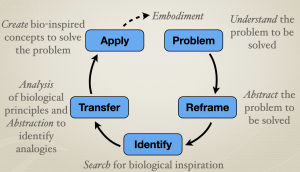The practice of learning from nature to develop innovative solutions is an old concept that didn’t have a name until the 1990s when the book “Biomimicry: Innovation Inspired By Nature” written by Janine Benyus was published. This concept was further popularized by the Biomimicry Institute and multiple biomimicry consultancies. Although an international standard (ISO 18458) focused on terminology, concepts and methodology was published in 2015, the name for this concept still varies widely depending on geographical location, disciplinary training, and level of experience with the topic. Biomimicry, Biomimetics, and Bio-inspired Design are the top three, but Nature Inspired Design or Nature Inspired Innovation are also used. While there are some philosophical differences between these terms, they all tend to be used to describe the same thing – an interdisciplinary design approach that involves learning about biological principles to solve human problems. Engineering tends to use bio-inspired design (BID), and is the term I have adopted in my work.
It is important to note that there are adjacent design approaches that are not classified as BID! The use of biological material in a design is considered bio-utilization. An example of this would be a bio-sensor that uses a protein or enzyme as part of the sensing mechanism. Designs that visually resemble elements from nature are considered bio-morphic. An example of this would be a wind turbine that looks like a tree. If the design uses nature or looks like nature, it is likely not BID. A critical element of BID is learning about the biology (how the form/structure influences the function, system interconnections and processes, system of system interactions, etc.) which is needed to make the connections for how to apply resources differently.
In my time researching BID, I have seen exponential growth in the number of solutions and innovations inspired by nature. Studying and applying nature’s solutions to problems has led to technical innovation! See the growing list here.
Biomimetic technical innovation can occur following two major paths: 1) Problem-driven and 2) Biology-driven. The first one is the one engineers are most familiar with – find a solution to a given problem. I define the process of problem-driven bio-inspired design using the following diagram. Once the bio-inspired concept is defined, then the design process moves into the embodiment and testing phases. The second path is essentially the same but starts at the identify step of the process, and does not happen as frequently because it relies on chance.

From my own work and from researching in this field I have come to recognize that there is a feedback loop that occurs between knowledge transfer (Transfer) and application of that knowledge (Apply). I like to call this the discovery of innovations loop as connections between biology and engineering (or a different problem domain) are being refined through iterative knowledge building, connection making and idea generation. This is what helped me to identify C-K theory as a means to create innovative pedagogical materials.
What makes BID somewhat tricky is figuring out how to navigate the vast amounts of biological information, and accepting that there is no “right” biological inspiration. For example, the butterfly wing has inspired a digital display viewable in sunlight, color changing paint without pigments, self-cleaning surfaces, and a way to increase solar panel efficiency. That is why having the right mindset and skills can help. Key skills include: curiosity, abstraction, recognizing the difference between inspiration and imitation, identifying scientific/engineering principles in biology, and re-framing. Application of tools and frameworks help to build the skills necessary to practice BID while the mindset helps to set expectations of the practice.
With the right mindset, bio-inspired design can be an innovative practice for solving problems.
The mindset that enables successful bio-inspired design practice is summarized as the following:
- Biology First – Learns the biology and considers the context.
- Inspiration – Uses a mix of physical and non-physical information about the biological system.
- Risk – Engages in an intellectual activity with high uncertainty that could fail or lead to an innovative solution, as well as understands that a single biological system can inspire solutions to multiple problems.
- Development – Recognizes that design with inspiration from nature is a process similar to other design processes.
- Scope – Understands that size and type of problem impacts the result, as well as recognizes that not all aspects of a solution have to be bio-inspired.
Each skill can be developed using a range of tools, and some can be applied at multiple steps in the process. By focusing on building mindset and skills, people can find what works for them and gain the confidence needed to follow a process. Think of it like this: Building a mindset is like putting together a puzzle. The mindset establishes the boundary of the puzzle. Learning individual skills is like examining pieces in detail and then placing them on the table. As more skills are learned, more pieces fit together and the connection to the boundary becomes clearer. Once the puzzle is complete the big picture becomes clear.
Use the menu at the top or these links to learn more about my research and consulting, as well as resources for your project.